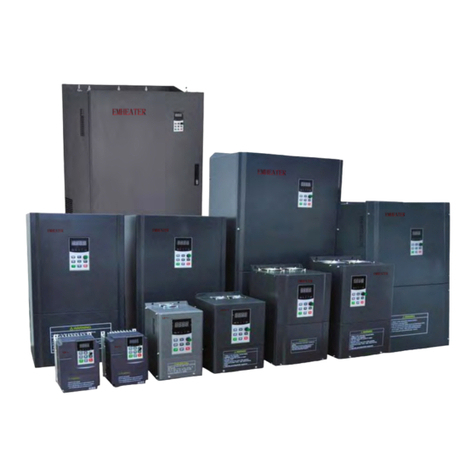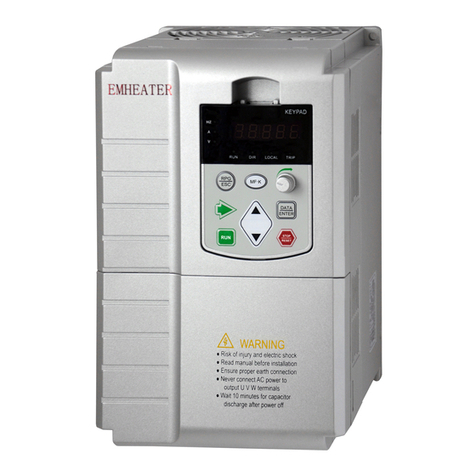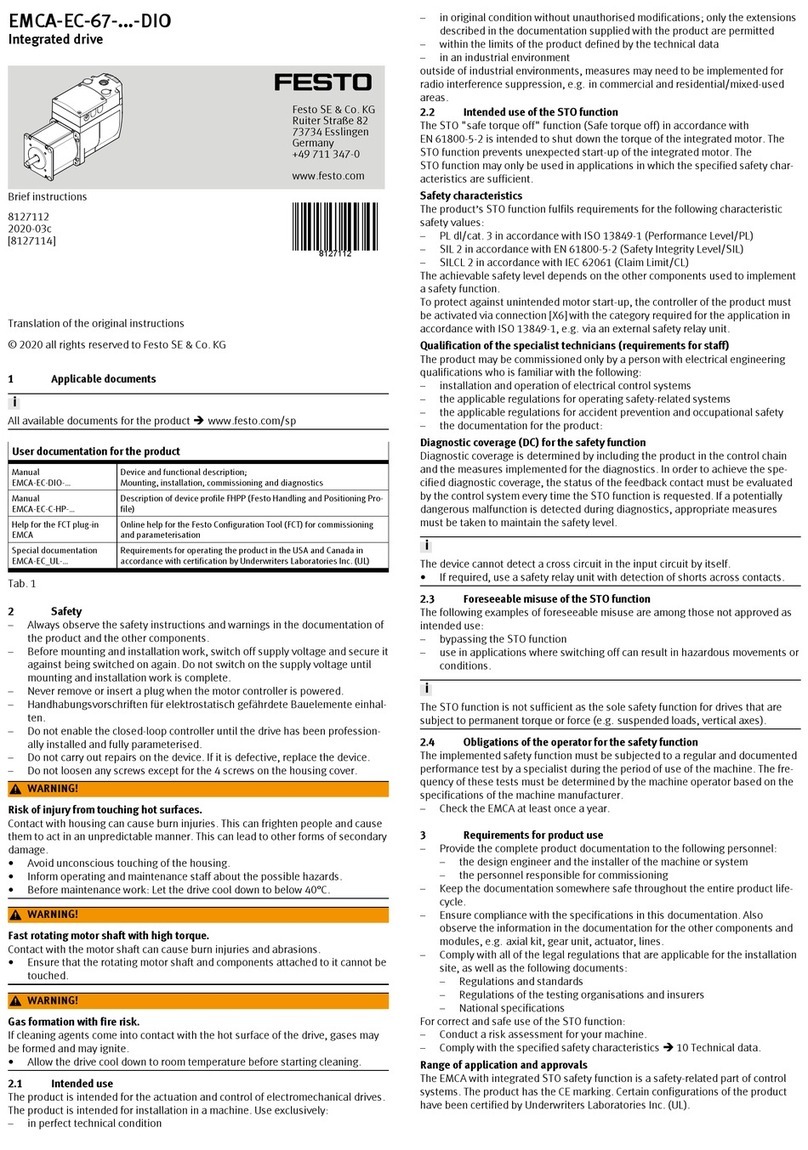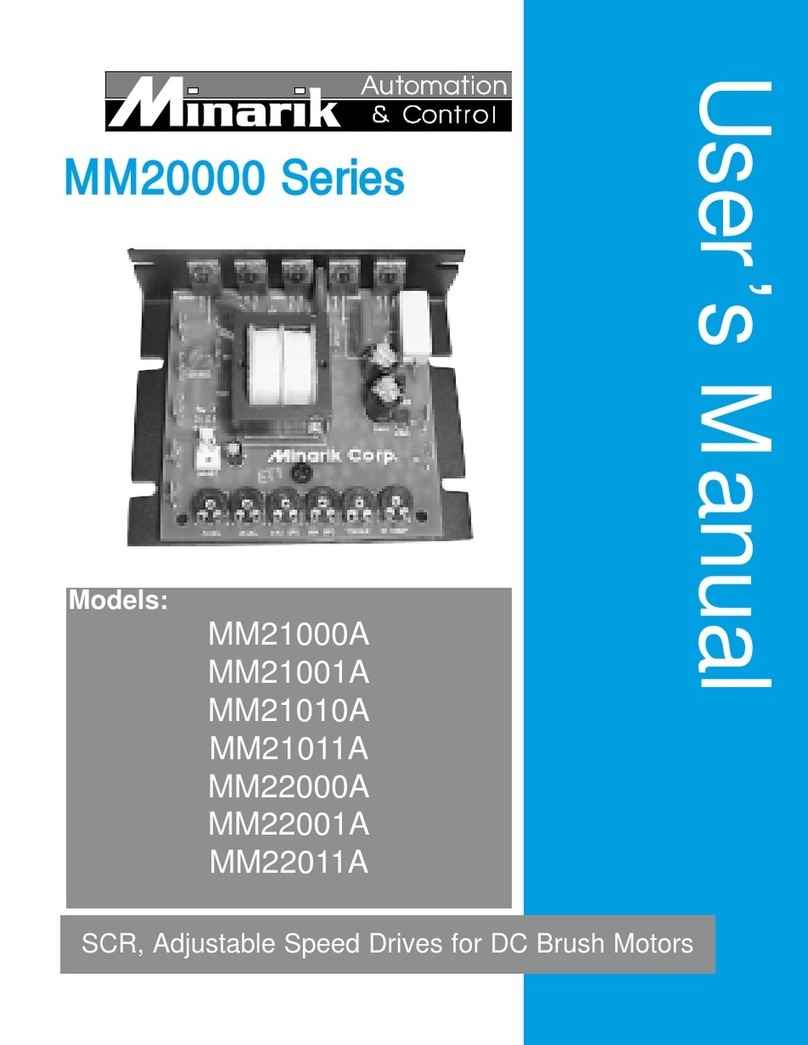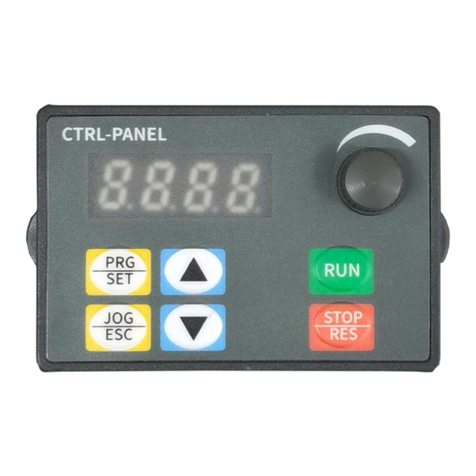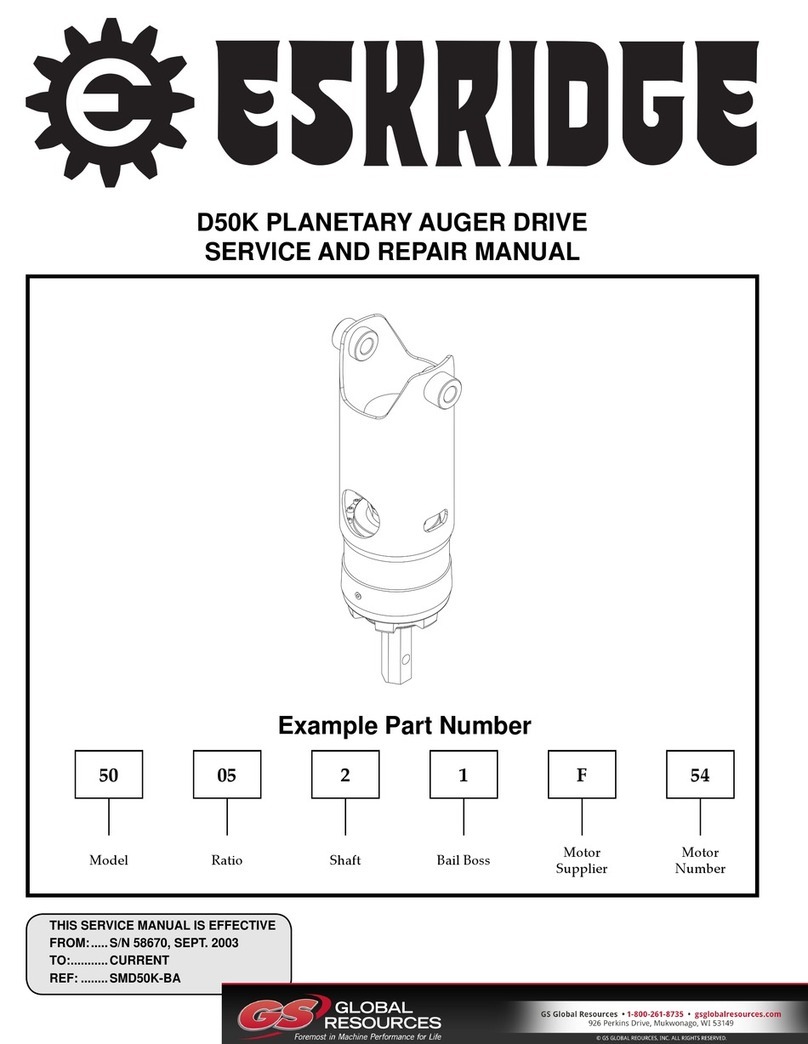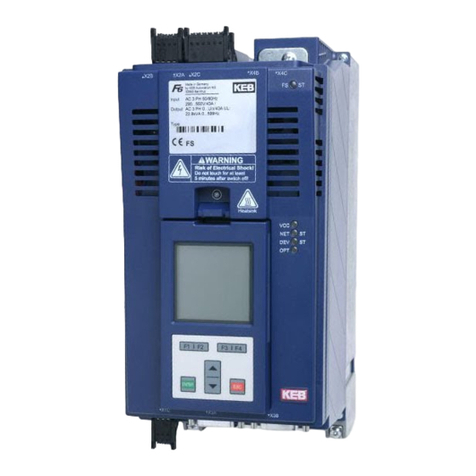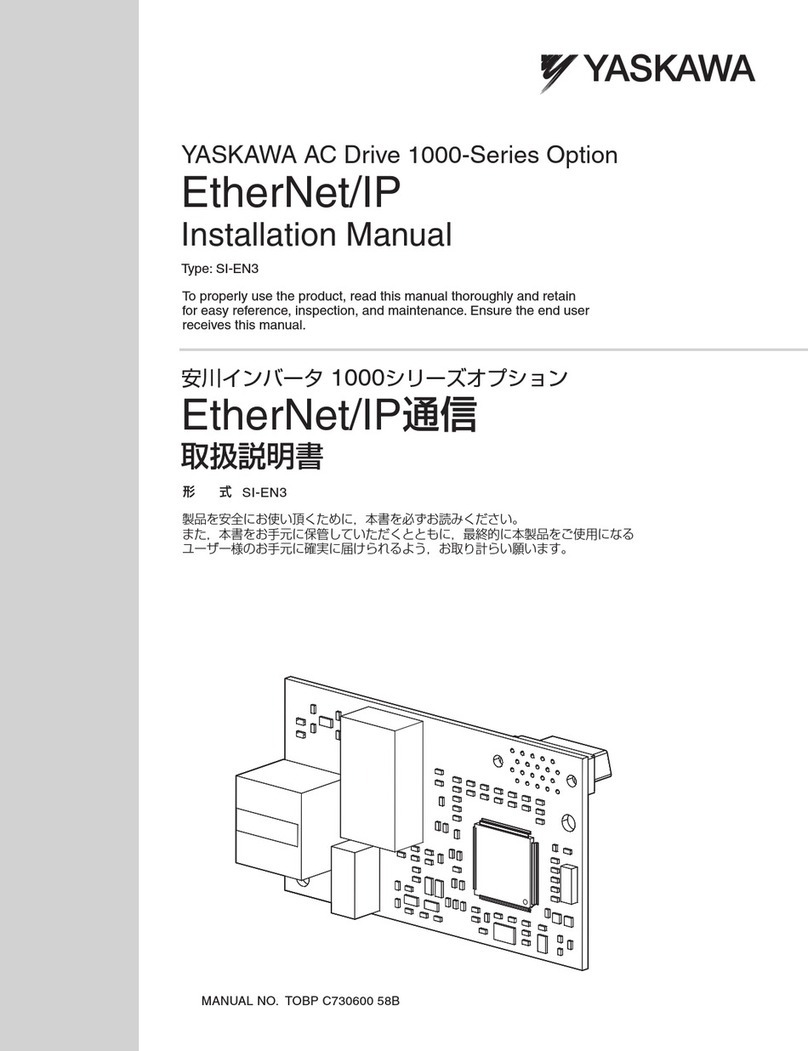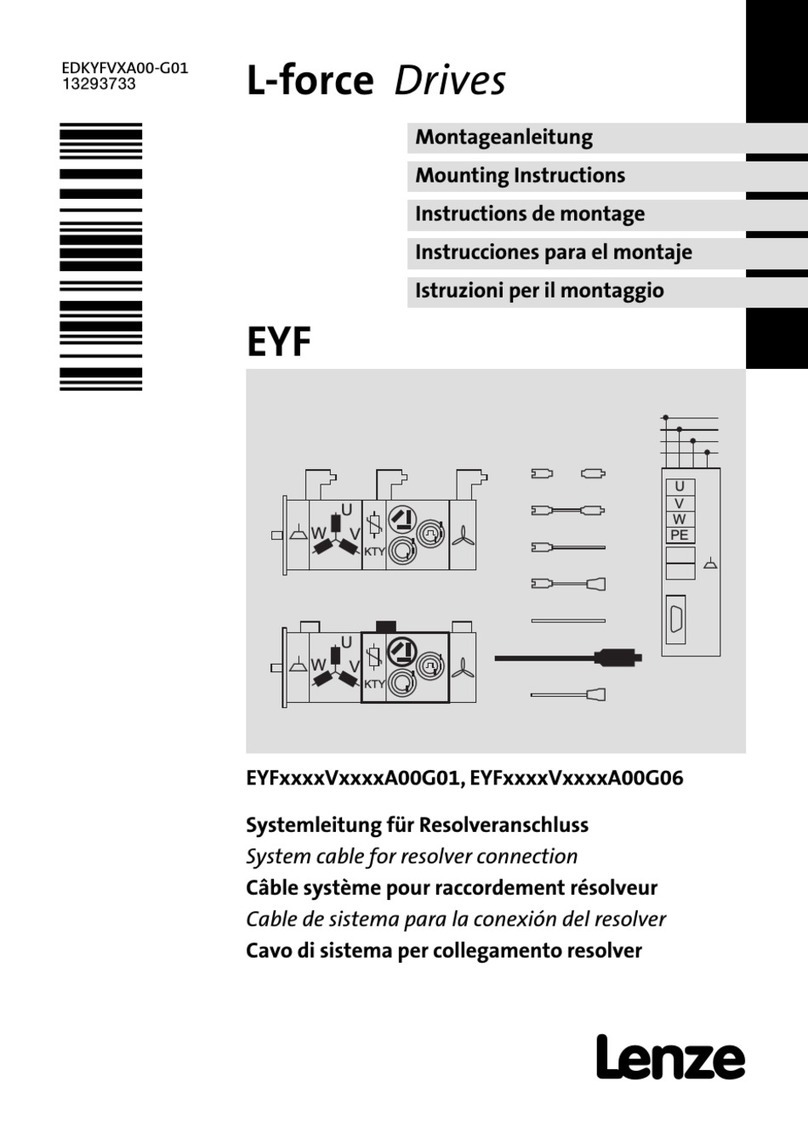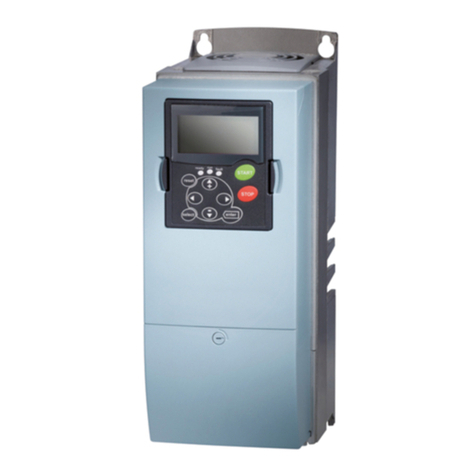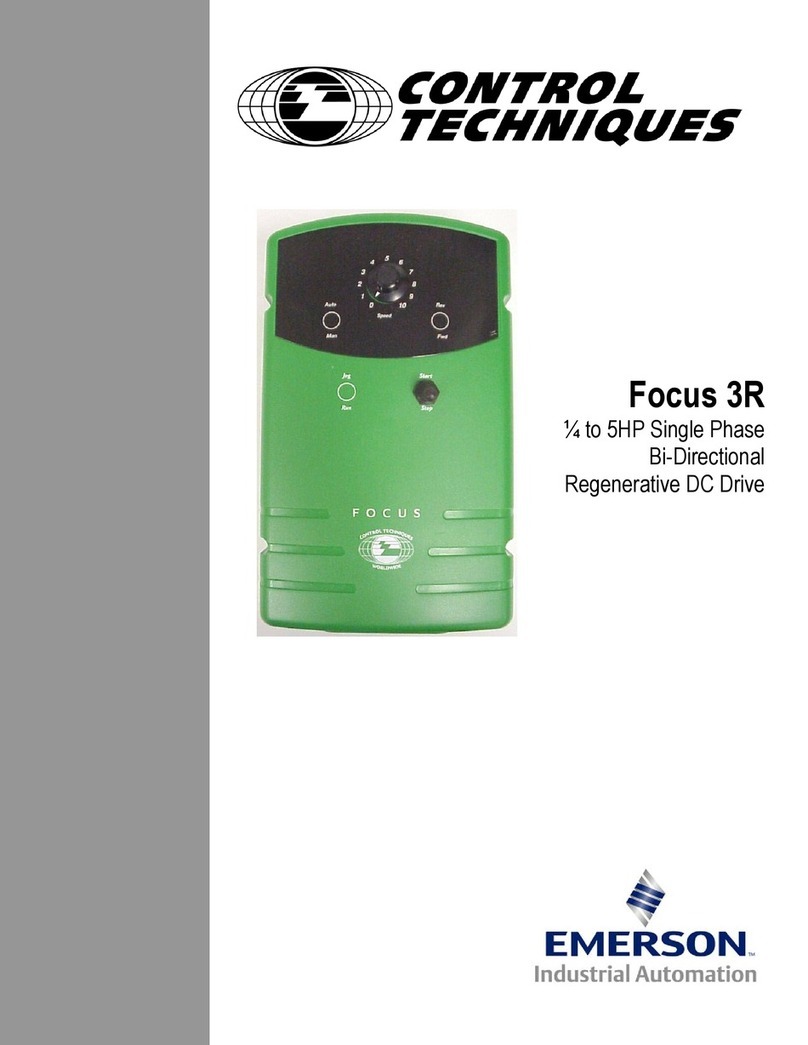Emheater EM15 Series User manual

EM15 Series Frequency Inverter

EM15 User’s Manual Preface
I
Preface
Thank you for purchasing the EM15 series frequency inverter developed by China EM Technology Limited.
EM15 series inverter is our company adopted the new concept to research and developed high-performance
product. With unique control model, this inverter can realize high torque, high precision, wide variable speed and
low noise drive; And PID regulation, simple PLC, flexible input and output terminals, Auto voltage regulation,
rapid Current Limit, Torque limited and control, field bus control and a series of practical operation, control function,
which provide a highly integrated solution for equipment manufacturers and customers, in speed, energy saving,
automatic control and other aspects, to meet the application demands for different customers.
Before unpacking, please check carefully:
⚫Whether the nameplate model of frequency inverter are consistent with your order ratings. The box contains
the frequency inverter, user manual.
⚫Whether the frequency inverter is damaged during transportation. If you find any omission or damage, please
contact us or your local supplier immediately.
First-time Use
For the users who use this product for the first time, read the manual carefully. If in doubt concerning some
functions or performances, contact the technical support personnel to ensure correct use.
Due to the continuous improvement of frequency inverter, this document will be updated without prior notice.
EM15 series frequency inverter complies with the following international standards. All products have acquired
the CE certification.
IEC/EN61800-5-1: 2003 Variable speed electric drive system safety requirements;
IEC/EN61800-3: 2004 Variable speed electric drive system, Part 3: The Electro Magnetic Compatibility (EMC)
Standards of Product and its specific testing methods.
Note:
⚫There are all parameters list integrated at appendix II.
Version:V1.0.12

Table of Contents EM15 User’s Manual
II
Table of Contents
1. Safety Information and Precautions.............................................................................................................1
1.1 Safety Information.................................................................................................................................1
1.2 General Precautions...............................................................................................................................3
2. Product Information.....................................................................................................................................5
2.1 Products Lable and Model Designation.................................................................................................5
2.1.1 Product appearance.............................................................................................................................5
2.2 Technical Specifications........................................................................................................................6
2.3 Model and Technical data......................................................................................................................7
2.4 Product appearance and installation dimension.....................................................................................9
2.5 Daily maintenance of frequency inverters...........................................................................................12
2.6 Selection Guide of braking component ...............................................................................................13
3. Installation of Frequency Inverter..............................................................................................................16
3.1 Installation environment......................................................................................................................16
3.2 Installation direction and space............................................................................................................16
3.3 Peripheral Devices Connection Diagram.............................................................................................17
3.4 Instructions of Main Circuit Peripheral Devices .................................................................................17
3.5 Model Selection of Main Circuit Peripheral Devices..........................................................................18
3.6 Removal and mounting of operating panel and cover.........................................................................19
3.7 Connection Terminals Diagram Description........................................................................................21
3.8 Sketch and Description of Main Circuit Terminals .............................................................................21
3.9 Cautions for Main Circuit Wiring........................................................................................................23
3.10 Control Circuit and Main Circuit Terminals Description ..................................................................25
4. Operation and display................................................................................................................................29
4.1 Instruction of operation and display ....................................................................................................29
4.2 Viewing and Modifying Function Codes.............................................................................................30
4.3 Monitoring Status Parameters..............................................................................................................30
4.4 Password Setting..................................................................................................................................31
4.5 Motor parameter auto-tuning...............................................................................................................31
5. Description of Function Codes..................................................................................................................32
5.1 Group b0: Basic Function Parameters.................................................................................................32
5.2 Group b1: Start/Stop Control Parameters............................................................................................40
5.3 Group b2: Auxiliary Functions............................................................................................................42
5.4 Group b3: Input Terminals...................................................................................................................47
5.5 Group b4: Output Terminals................................................................................................................53
5.6 Group b5: Pulse/Analog input terminals .............................................................................................59
5.7 Group b6: Pulse/analog output terminals.............................................................................................62
5.8 Group b7: Virtual digital input (VDI)/digital output (VDO) terminals ...............................................63
5.9 Group b9: Keypad and Display ...........................................................................................................66
5.10 Group bA: Communication parameters.............................................................................................69
5.11 Group bb: Fault and Protection..........................................................................................................70
5.12 Group bC: Fault detection Parameters...............................................................................................76
5.13 Group bd Motor protection................................................................................................................77
5.14 Group C0: Process Control PID Function .........................................................................................77
5.15 Group C1:Multi-function...................................................................................................................82
5.16 Group C2: Simple PLC......................................................................................................................84

EM15 User’s Manual Table of Contents
III
5.17 Group C3: Constant pressure water supply parameters.........................................................................88
5.18 Group d0: Motor Parameters.............................................................................................................88
5.19 Group d1: Motor vector control parameters......................................................................................91
5.20 Group d2: Motor V/F Control Parameters.........................................................................................94
5.21 Group d6: Control Optimization Parameters 1..................................................................................99
5.22 Group U0: Monitoring Parameters..................................................................................................100
5.23 Group A0: System parameters.........................................................................................................105
5.24 Group A2: Control Optimization Parameters 2 ...............................................................................106
6. EMC (Electromagnetic compatibility).....................................................................................................108
6.1 Definition...........................................................................................................................................108
6.2 EMC Standard Description................................................................................................................108
6.3 EMC Guide........................................................................................................................................108
7. Fault Diagnosis and Solution...................................................................................................................111
7.1 Fault Alarm and Countermeasures.....................................................................................................111
7.2 Common Faults and Solutions...........................................................................................................114
Appendix I.Modbus communication protocol.............................................................................................117
I. About Protocol......................................................................................................................................117
II. Application Methods...........................................................................................................................117
III. Bus structure......................................................................................................................................117
Appendix II. Function Code Table...............................................................................................................126
Appendix III ................................................................................................................................................156


EM15 User’s Manual 1. Safety Information and Precautions
1
1. Safety Information and Precautions
In this manual, the notices are graded based on the degree of danger:
Danger
Indicates that failure to comply with the notice will result in severe personal injury or
even death.
Warning
Indicates that failure to comply with the notice will result in personal injury or
property damage.
Read this manual carefully so that you have a thorough understanding. Installation, commissioning or
maintenance may be performed in conjunction with this chapter. EMHEATER will assume no liability or
responsibility for any injury or loss caused by improper operation.
1.1 Safety Information
Before
installation
Danger
⚫Do not use damaged or missing components frequency inverter. Failure to
comply will result in personal injury.
⚫Please use the electric motor with upper B insulation class. Failure to comply
will result in personal injury.
During
installation
Danger
⚫Install the frequency inverter on incombustible objects such as metal, and keep it
away from combustible materials. Failure to comply may result in a fire.
Warning
⚫When two frequency inverters are laid in the same cabinet, arrange the
installation positions properly to ensure the enough cooling effect.
⚫Do not drop wire residue or screw into the frequency inverter. Failure to comply
will result in damage to the frequency inverter.
Wiring
Danger
⚫Wiring must be performed only by qualified personnel under instructions
described in this manual. Failure to comply may result in unexpected accidents.
⚫A circuit breaker must be used to isolate the power supply and the frequency
inverter. Failure to comply may result in a fire.
⚫Ensure that the power supply is cut off before wiring. Failure to comply may
result in electric shock.
⚫Connect the frequency inverter to ground properly by standard. Failure to
comply may result in electric shock.
Warning
⚫Never connect the power supply cables to the output terminals (U, V, W) of the
Frequency inverter. Failure to comply will result in damage to the frequency
inverter.
⚫Make sure that all the connecting wires comply with the requirement of EMC
and the safety standard in the region. Use wire sizes recommended in the
manual. Failure to comply may result in accidents.
⚫Never connect the braking resistor between the DC bus terminals (P+) and (P-).
Failure to comply may result in a fire.

1. Safety Information and Precautions EM15 User’s Manual
2
Before
power-on
Danger
⚫Check that the following requirements comply with:
The voltage class of the power supply is consistent with the rated voltage class of
the frequency inverter. The input terminals (R, S, T) and output terminals (U, V,
W) are properly connected. No short-circuit exists in the peripheral circuit. The
wiring is fastened. Failure to comply will result in damage to frequency inverter.
⚫Cover the frequency inverter properly before power-on to prevent electric shock.
Before
power-on
Warning
⚫Do not perform the voltage resistance test on any part of the frequency inverter
because such test has been done in the factory. Failure to comply will result in
accidents.
⚫All peripheral devices must be connected properly under the instructions
described in this manual. Failure to comply will result in accidents.
After
power-on
Danger
⚫Do not open the frequency inverter’s cover after power-on to prevent from
electric shock.
⚫Do not touch the frequency inverter with wet hand and its peripheral circuit to
prevent from electric shock.
⚫Do not touch the terminals of the frequency inverter (including the control
terminals). Failure to comply may result in electric shock.
⚫Do not touch the U, V, W terminal or motor connecting terminals when
frequency inverter automatically does safety testing for the external high-voltage
electrical circuit. Failure to comply may result in electric shock.
Warning
⚫Note the danger during the rotary running of motor when check the parameters.
Failure to comply will result in accidents.
⚫Do not change the factory default settings of the frequency inverter. Failure to
comply will result in damage to the frequency inverter.
During
operation
Danger
⚫Do not go close to the equipment when selected the restart function. Failure to
comply may result in personal injury.
⚫Do not touch the fan or the discharging resistor to check the temperature. Failure
to comply will result in personal injury.
⚫Signal detection must be performed only by qualified personal during operation
Warning
⚫Avoid objects falling into the frequency inverter when it is running. Failure to
comply will result in damage to frequency inverter.
⚫Do not start/stop the frequency inverter by turning the contactor ON/OFF.
Failure to comply will result in damage to the frequency inverter.
Maintenance
Danger
⚫Do not repair or maintain the frequency inverter at power-on. Failure to comply
will result in electric shock.
⚫Repair or maintain the frequency inverter only after the charge light on
frequency inverter is powered off. This allows for the residual voltage in the
capacitor to discharge to a safe value. Failure to comply will result in personal
injury.
⚫Repair or maintenance of the frequency inverter may be performed only by
qualified personnel. Failure to comply will result in personal injury or damage to
the frequency inverter.

EM15 User’s Manual 1. Safety Information and Precautions
3
1.2 General Precautions
1.2.1 Motor insulation test
Perform the insulation test when the motor is used for the first time, or when it is reused after being stored for a
long time, or in a regular check-up, in order to prevent the poor insulation of motor windings from damaging the
frequency inverter. The motor must be disconnected from the frequency inverter during the insulation test. A
500-V mega-Ohm meter is recommended for the test. The insulation resistance must not be less than 5 MΩ.
1.2.2 Thermal protection of motor
If the rated capacity of the motor selected does not match that of the frequency inverter, especially when the
frequency inverter's rated power is greater than the motor's, adjust the motor protection parameters on the
operation panel of the frequency inverter or install a thermal relay in the motor circuit for protection.
1.2.3 Running at over 50 Hz
The frequency inverter provides frequency output from 0 to 3200 Hz with V/F mode (300 Hz is supported for
frequency inverter running at FVC and SVC mode). If the frequency inverter is required to run at over 50 Hz,
please consider the bearable capacity of the machine.
1.2.4 Vibration of mechanical device
The frequency inverter may encounter the mechanical resonance point at some output frequency points, which can
be avoided by setting the skip frequency.
1.2.5 Motor heat and noise
The output of the frequency inverter is pulse width modulation (PWM) wave with certain harmonic frequencies,
and therefore, the motor temperature, noise, and vibration are slightly greater than those motor runs at grid power
frequency (50 Hz).
1.2.6 Voltage-sensitive device or capacitor at output side of the Frequency inverter
Do not install the capacitor for improving power factor or lightning protection voltage-sensitive resistor at the
output side of the frequency inverter because the output of the frequency inverter is PWM wave. Otherwise, the
frequency inverter may suffer transient over current and even to be damaged.
1.2.7 Contactor at the Input or Output side of the frequency inverter
When contactor is installed between the input side of the frequency inverter for the power supplying, the
frequency inverter must not be started or stopped by the contactor switching on or off. If the frequency inverter
has to be operated by the contactor, ensure that the time interval between switching is at least one hour. Since
frequently charge and discharge will shorten the service life of the capacitor inside of the frequency inverter.
When a contactor is installed between the output side of the frequency inverter and the motor, do not turn off the
contactor when the frequency inverter is running. Otherwise, IGBT modules inside of frequency inverter may be
damaged.
1.2.8 When input voltage is over rated voltage range
The frequency inverter must not be used over the allowable voltage range specified in this manual. Otherwise, the
frequency inverter's components may be damaged. If required, please use a corresponding voltage transformer
device.
1.2.9 Prohibition of three-phase input changed into two-phase input
Do not change the three-phase power input of the frequency inverter to two-phase input. Otherwise, frequency

1. Safety Information and Precautions EM15 User’s Manual
4
inverter will be damaged.
1.2.10 Surge suppressor
The frequency inverter has a built-in voltage sensitive resistor for suppressing the surge voltage. Using frequently
surge place, please add extra surge voltage protection device at input side of frequency inverter.
Note: Do not add the surge suppressor at the output side of the frequency inverter.
1.2.11 Altitude and de-rating using
Where the altitude is above 1000 m and the cooling effect WEAKEN due to thin air, it is necessary to de-rate the
power of frequency inverter. Please contact our company for technical supporting.
1.2.12 Some special application
If wiring that is not described in this manual such as shared DC bus is applied, please contact the agent or our
company for technical supporting.
1.2.13 Scrap disposition
The electrolytic capacitors on the main circuit and PCB board may explode when they are burning. Poisonous gas
is generated when the plastic parts are burning. Please treat them as industrial waste by special way.
1.2.14 Matched Motor
The standard matched motor is suitable four-pole squirrel-cage asynchronous induction motor. For other types of
motor, please select a proper frequency inverter according to the rated motor current. If user uses inverter for
permanent magnet synchronous motor, please contact my company for selecting another series inverter..
The cooling fan is coaxial to rotor shaft of non-variable-frequency motor, which will reduce cooling effect when
the shaft rotational speed decreasing. If motor is required variable speed, add a separately cooling fan or replace
motor to variable-frequency motor.
The common standard parameters of the matched motor have been configured inside the frequency inverter. It is
still necessary to perform motor auto-tuning or modify the default values based on actual application. Otherwise,
the running result and protection performance will be weaken.
The frequency inverter may alarm and even be damaged when short-circuit exists on cables or inside the motor.
Therefore, perform insulation test when the motor and cables are newly installed or during routine maintenance.
During the test, make sure the frequency inverter is disconnected from the tested parts.

EM15 User’s Manual 2. Product Information
5
2. Product Information
2.1 Products Lable and Model Designation
EM15 Series Frequency Inverter
,
Products Type:
G: General use
P: Fan&Pump
,
Voltage range:
1: Single phase 220V
13: Single phase 220V to Three phase 380
2: Three phase 220V
3: Three phase 380V
4: Three phase 480V
5: Three phase 575V
6: Three phase 660V
,
Adaptable motor: 7d5: 7.5KW ;011: 11KW
Diagram 2-1 Products Label and Designation rules
2.1.1 Product appearance
Diagram 2-2 Nameplate
The housing types of the EM15 models are listed in the following table:
Plastic
Sheet metal
1PH 220V
0.75kW~2.2kW
--
3PH 220V
0.75kW~11kW
15kW~250kW
3PH 380V
0.75kW~22kW
30kW~500kW
3PH 480V
0.75kW~22kW
30kW~500kW

2. Product Information EM15 User’s Manual
6
2.2 Technical Specifications
Input
&Output
⚫Input Voltage: 220V/380V/480V/575V/660V±15%
⚫Input Frequency: 47~63Hz
⚫Input Frequency Resolution: 0.01Hz (Digital setting); maximum frequency×0.025% (Analog setting)
⚫Output Voltage:0~Rated input voltage
⚫Output Frequency: 0~320Hz(SFC); 0~3200Hz (V/F)
Technical Performance
⚫Control Mode:Sensor-less vector control(SVC); Closed-loop vector control (FVC); Voltage/Frequency
(V/F) control
⚫Carrier Frequency:0.5kHz~16kHz
⚫Startup Torque: G type: 0.5Hz/150% (FVC); 0Hz/180%(FVC); P type: 0.5Hz/100%
⚫Speed Range:1:100(SVC);1:1000(FVC)
⚫Speed Stability Accuracy:±0.5%(SVC);±0.02%(FVC)
⚫Torque Control Accuracy:±5%(FVC)
⚫Overload Capacity:G type:150% rated current 60s; 180% rated current 3s; P type: 120% rated current
60s;150% rated current 3s.
⚫Torque Boost:Auto boost; Manual boost 0.1%~30.0%
⚫DC braking:0.00Hz~maximum frequency (DC braking frequency); 0.0s~36.0s(Braking time);
0.0%~100.0%( Braking trigger current value)
Individualized Functions
⚫Built-in Simple PLC / Multiple Speeds:It realizes up to 16 speeds via the simple PLC function or
combination of DI terminal states.
⚫Built-in PID:It realizes closed loop control system easily.
⚫Auto voltage regulation (AVR): It can keep constant output voltage automatically when the mains
voltage fluctuation
⚫Overvoltage/ Overcurrent Stall Control:The current and voltage are limited automatically during the
running process so as to avoid frequently tripping due to overvoltage / over current.
⚫Rapid Current Limit: To avoid frequently over current faults of the frequency inverter.
⚫Torque Limit and Control:It can limit the torque automatically and prevent frequently over current
tripping during the running process. Torque control can be implemented in the VC mode.
⚫High Performance:Control of asynchronous motor is implemented through the high-performance current
vector control technology.
⚫Virtual I/O:Five groups of virtual DI/DO can realize simple logic control.
⚫Timing Control:Time range: 0.0~6500.0 minutes
⚫Motor Overheat Protection:The optional I/O extension card enables AI3 to receive the motor
temperature sensor input (PT100, PT1000) so as to realize motor overheat protection.
⚫Multiple Encoder Types:It supports differential encoder, open-collector encoder
⚫Protection Mode:Motor short-circuit detection after power-on, input/output phase loss protection, over
current and overvoltage protection, less voltage protection, overheat protection and overload protection,etc
External Interface
⚫Running Command Giving:key panel; Control terminals; Serial communication port; You can switch
between these giving in various ways.
⚫Frequency Giving:There are 10 kinds frequency giving: digital setting, analog voltage setting, analog
current setting, pulse setting and serial communication port setting.
⚫Programmable Digital Input: 6 digital input (DI) terminals, one of which supports up to 100 kHz
high-speed pulse input
⚫Programmable Analog Input: 3 analog input (AI) terminals, AI1,AI2 support 0V~10 V or 0mA~20mA
input,AI3 support -10V~+10V
⚫Programmable Open Collector Output: 1 FMP output terminal, that supports 0–100 kHz square wave
signal output (Can be used as DO output)
⚫Programmable Analog Output:2 analog output (AO) terminals,both of them supports 0mA~20mA
current output and 0V~10V voltage output.
⚫Relay Output: 2 relay output terminal (2.2KW and below only have 1 relay output terminal)
Environment
⚫Installation Location:Indoor, no direct sunlight, dust, corrosive gas, combustible gas, oil smoke, vapour,
drip or salt.
⚫Altitude:Lower than 1000m
⚫Ambient Temperature:-10°C~ +40°C (de-rated if the ambient temperature is between 40°C and 50°C)
⚫Humidity:Less than 95%RH, without condensing
⚫Vibration:Less than 5.9 m/s2 (0.6 g)
⚫Storage Temperature:-20°C ~ +60°C

EM15 User’s Manual 2. Product Information
7
2.3 Model and Technical data
Model
Power Capacity
(KVA)
Input Current
(A)
Output Current
(A)
Adaptable Motor
KW
HP
Single phase 220V 50/60Hz
EM15-G1-d75
1.5
8.2
4
0.75
1
EM15-G1-1d5
3
14
7
1.5
2
EM15-G1-2d2
4
23
9.6
2.2
3
Three phase 220V 50/60Hz
EM15-G2-d75
3
5
3.8
0.75
1
EM15-G2-1d5
4
5.8
5.1
1.5
2
EM15-G2-2d2
5.9
10.5
9
2.2
3
EM15-G2-004
8.9
14.6
17
3.7
5
EM15-G2-5d5
17
26
25
5.5
7.5
EM15-G2-7d5
21
35
32
7.5
10
EM15-G2-011
30
46.5
45
11
15
EM15-G2-015
40
62
60
15
20
EM15-G2-018
57
76
75
18.5
25
EM15-G2-022
69
92
91
22
30
EM15-G2-030
85
113
112
30
40
EM15-G2-037
114
157
150
37
50
EM15-G2-045
134
180
176
45
60
EM15-G2-055
160
214
210
55
75
EM15-G2-075
231
307
304
75
100
Three phase 380V 50/60Hz
EM15B-G3-d75/P3-1d5
1.5/3
5/5.8
2.1/3.8
0.75/1.5
1/2
EM15B-G3-1d5/P3-2d2
3/4
5.8/10.5
3.8/5.1
1.5/2.2
2/3
EM15B-G3-2d2/P3-004
4/5.9
10.5/14.6
5.1/9
2.2/3.7
3/5
EM15-G3-004/P3-5d5
5.9/8.9
14.6/20.5
9/13
3.7/5.5
5/7.5
EM15-G3-5d5/P3-7d5
8.9/11
20.5/26
13/17
5.5/7.5
7.5/10
EM15-G3-7d5/P3-011
11/17
26/35
17/25
7.5/11
10/15
EM15-G3-011/P3-015
17/21
35/38.5
25/32
11/15
15/20
EM15-G3-015/P3-018
21/24
38.5/46.5
32/37
15/18.5
20/25
EM15-G3-018/P3-022
24/30
46.5/62
37/45
18.5/22
25/30
EM15-G3-022/P3-030
30/40
62/76
45/60
22/30
30/40
EM15-G3-030/P3-037
40/57
76/92
60/75
30/37
40/50
EM15-G3-037/P3-045
57/69
92/113
75/91
37/45
50/60
EM15-G3-045/P3-055
69/85
113/128
91/112
45/55
60/75
EM15-G3-055/P3-075
85/114
128/157
112/150
55/75
75/100
EM15-G3-075/P3-090
114/134
157/180
150/176
75/90
100/125
EM15-G3-090/P3-110
134/160
180/214
176/210
90/110
125/150
EM15-G3-110/P3-132
160/192
214/256
210/253
110/132
150/200
EM15-G3-132/P3-160
192/231
256/307
253/304
132/160
200/250
EM15-G3-160/P3-200
231/250
307/385
304/377
160/200
250/280
EM15-G3-200/P3-220
250/280
385/430
377/426
200/220
280/300

2. Product Information EM15 User’s Manual
8
Model
Power Capacity
(KVA)
Input Current
(A)
Output Current
(A)
Adaptable Motor
KW
HP
EM15-G3-220/P3-250
280/355
430/468
426/465
220/250
300/370
EM15-G3-250/P3-280
355/396
468/525
465/520
250/280
370/400
EM15-G3-280/P3-315
396/445
525/590
520/585
280/315
400/420
EM15-G3-315/P3-355
445/500
590/665
585/650
315/355
420/500
EM15-G3-355
500
665
650
355
500
EM15-G3-400
560
785
725
400
530
EM15-G3-450
630
883
820
450
600
EM15-G3-500
800
920
860
500
660
Three phase 480V 50/60Hz
EM15B-G4-d75/P4-1d5
1.5/3
5/5.8
2.1/3.8
0.75/1.5
1/2
EM15B-G4-1d5/P4-2d2
3/4
5.8/10.5
3.8/5.1
1.5/2.2
2/3
EM15B-G4-2d2/P4-004
4/5.9
10.5/14.6
5.1/9
2.2/3.7
3/5
EM15-G4-004/P4-5d5
5.9/8.9
14.6/20.5
9/13
3.7/5.5
5/7.5
EM15-G4-5d5/P4-7d5
8.9/11
20.5/26
13/17
5.5/7.5
7.5/10
EM15-G4-7d5/P4-011
11/17
26/35
17/25
7.5/11
10/15
EM15-G4-011/P4-015
17/21
35/38.5
25/32
11/15
15/20
EM15-G4-015/P4-018
21/24
38.5/46.5
32/37
15/18.5
20/25
EM15-G4-018/P4-022
24/30
46.5/62
37/45
18.5/22
25/30
EM15-G4-022/P4-030
30/40
62/76
45/60
22/30
30/40
EM15-G4-030/P4-037
40/57
76/92
60/75
30/37
40/50
EM15-G4-037/P4-045
57/69
92/113
75/91
37/45
50/60
EM15-G4-045/P4-055
69/85
113/128
91/112
45/55
60/75
EM15-G4-055/P4-075
85/114
128/157
112/150
55/75
75/100
EM15-G4-075/P4-090
114/134
157/180
150/176
75/90
100/125
EM15-G4-090/P4-110
134/160
180/214
176/210
90/110
125/150
EM15-G4-110/P4-132
160/192
214/256
210/253
110/132
150/200
EM15-G4-132/P4-160
192/231
256/307
253/304
132/160
200/250
EM15-G4-160/P4-200
231/250
307/385
304/377
160/200
250/280
EM15-G4-200/P4-220
250/280
385/430
377/426
200/220
280/300
EM15-G4-220/P4-250
280/355
430/468
426/465
220/250
300/370
EM15-G4-250/P4-280
355/396
468/525
465/520
250/280
370/400
EM15-G4-280/P4-315
396/445
525/590
520/585
280/315
400/420
EM15-G4-315/P4-355
445/500
590/665
585/650
315/355
420/500
EM15-G4-355
500
665
650
355
500
EM15-G4-400
560
785
725
400
530
EM15-G4-450
630
883
820
450
600
EM15-G4-500
800
920
860
500
660

EM15 User’s Manual 2. Product Information
9
2.4 Product appearance and installation dimension
2.4.1 Appearance and Installation Hole Dimension (mm)
Diagram 2-3 Three phase 0.75~2.2kW Wall-mounted installation dimensions
Matching inverter
Appearance and installing dimension (Unit: mm)
Voltege
Power Range
W
W1
H
H1
D
d
1PH 220V
0.75~2.2kW
101
90
152
141
132
Φ4
3PH 220V
0.75~2.2kW
3PH 380V
0.75~2.2 kW
3PH 480V
0.75~2.2 kW
Diagram 2-4 Three phase 4~22kW Wall-mounted installation dimensions
Matching inverter
Appearance and installing dimension (Unit: mm)
Voltege
Power Range
W
W1
H
H1
D
d
3PH 380V
4~5.5kW
120
108
205
195
166
Φ4.5
3PH 480V
4~5.5kW
3PH 220V
4~5.5kW
162
148
250
238
191
Φ5.5
3PH 380V
7.5~11kW
3PH 480V
7.5~11kW
3PH 220V
7.5~11kW
223
207
323
307
207
Φ5.5
3PH 380V
15~22kW
3PH 480V
15~22kW

2. Product Information EM15 User’s Manual
10
Diagram 2-5 Three phase 30~500kW Wall-mounted installation dimensions
Matching inverter
Appearance and installing dimension (Unit: mm)
Voltege
Power Range
W
W1
H
H1
D
d
3PH 220V
15~18.5kW
300
220
540
500
240
Φ7
3PH 380V
30~37kW
3PH 480V
30~37kW
3PH 220V
22~30kW
340
260
575
545
270
Φ10
3PH 380V
45~55kW
3PH 480V
45~55kW
3PH 220V
37~45kW
410
260
610
580
285
Φ12
3PH 380V
75~90kW
3PH 480V
75~90kW
3PH 220V
55kW
475
320
720
695
335
Φ12
3PH 380V
110~132kW
3PH 480V
110~132kW
3PH 220V
75kW
550
360
880
825
360
Φ12
3PH 380V
160~220kW
3PH 480V
160~220kW
3PH 380V
250~315kW
670
360
1040
985
415
Φ12
3PH 480V
250~315kW
3PH 380V
355~500kW
815
600
1300
1235
445
Φ12
3PH 480V
355~500kW

EM15 User’s Manual 2. Product Information
11
Diagram 2-6 Three phase 160~500kW Floor-mounted installation dimensions
Matching inverter
Appearance and installing dimension (Unit: mm)
Voltege
Power Range
W
W1
H
D
D1
d
3PH 220V
75kW
535
438
1397
370
252
Φ14
3PH 380V
160~220kW
3PH 480V
160~220kW
3PH 380V
250~315kW
650
558
1552
415
297
Φ14
3PH 480V
250~315kW
3PH 380V
355~500kW
815
722
1832
445
306
Φ14
3PH 480V
355~500kW
2.4.2Appearance and installation dimension of external keypad (keypad tray)
Diagram 2-7Appearance and installation dimension of small size external keypad (keypad tray)
Diagram 2-8Appearance and installation dimension of big size external keypad (keypad tray)

2. Product Information EM15 User’s Manual
12
2.5 Daily maintenance of frequency inverters
2.5.1 Daily maintenance
Due to the influence of temperature, humidity, dust and vibration, it will lead to poor heat dissipation and
component aging of frequency inverter, and results in potential failure or reducing the service life of frequency
inverter. Therefore, it is necessary to do daily and regular maintenance of the frequency inverter.
Daily check items:
1. Check if the frequency inverter sound is normal during the running of the motor;
2. Check if there is a vibration during the running of the motor;
3. Check whether the installation environment of frequency inverter has changed;
4. Check if the cooling fan of frequency inverter is working correctly, the cooling air duct is clear;
5. Check if the frequency inverter is overheating;
6. Make sure that the frequency inverter should always be kept in a clean state;
7. Clear up effectively the dust on the surface of the frequency inverter, prevent the dust from entering into the
inside of the frequency inverter, especially for the metal dust;
8. Clear up effectively the oil and dust on the cooling fan of frequency inverter.
2.5.2 Regular inspection
Please regularly check frequency inverter, especially for the difficult checking place during running.
Regular inspection items:
1. Check the air duct and clear up regularly;
2. Check if there are any loose screws;
3. Check if the inverter has been corroded;
4. Check whether the wiring terminals show signs of arcing.
Note: When using the megger(please use the DC 500V meg ohm meter) to measure the insulation resistance, you
shall disconnect the main circuit to the frequency inverter. Do not use the insulation resistance meter to test the
control circuit. Do not to do the high voltage test (It has been done when the frequency inverter producing in
factory.)
2.5.3 Replacement of wearing parts
The vulnerable parts of frequency inverter include the cooling fan and filter electrolytic capacitor, its service life is
closely related to the using environment and maintenance status. The general service life is:
Part Name
Service Life
Fan
3 to 4 Years
Electrolytic capacitor
5 to 6 Years
The user can confirm the replace time according to the running time.
1. Possible reasons for the damage of cooling fan: bearing wear and blade aging. Distinguish standard: Any
cracks in the fan blade, any abnormal vibration sound during the starting of frequency inverter.
2. Possible reasons for the damage of filting electrolytic capacitor: poor quality of the input power supply, the
environment temperature is higher, the load change frequently and the electrolyte aging. Distinguish standard:
Any leakage of its liquid, if the safety valve is protruding, please test capacitor electrostatic capacitance and
insulation resistance.
2.5.4 Storage of the frequency inverter
After buying the frequency inverter, users shall pay attention to the temporary and long-term storage as following:
1. Store the frequency inverter in the original packaging;

EM15 User’s Manual 2. Product Information
13
2. Long-term storage can lead to the degradation of electrolytic capacitors, and must ensure to power on for once
within 2 years. And the power-on time is at least 5 hours. The input voltage must slowly rise to the rating by
using the voltage regulator.
2.6 Selection Guide of braking component
Table 2-5 is the recommended value of braking resistor, users can select the different resistance value and power
according to the actual situation,(but the resistance value must not be less than the recommended value in the table,
and the power can be bigger.) The selection of braking resistance need to be confirmed according to the power
that the motor generated in the practical application systems, and is relevant to the system inertia, deceleration
time, the energy of the potential energy load, needs customers to choose according to actual situation. The greater
the inertia and the shorter deceleration time is needed more frequently braking, so the braking resistor needs the
one with bigger power but smaller resistance value.
2.6.1 Selection of braking resistance value
When braking, almost all the regenerated energy of motor is consumed by the braking resistor.
According to the formula: U * U/R = Pb
In the formula:
U --- The braking voltage when the system brake stably (different system is different, for the 380VAC system
generally take 700V)
R - Braking resistor value
Pb –Power of braking(W)
2.6.2 Selection power of braking resistor
In theory the power of braking resistor is consistent with the braking power, but it need to be taken into
consideration that the braking resistor power will derate to 70%.
According to the formula: 0.7*Pr=Pb*D
In this formula:
Pr----Power of resistor
D---- Braking proportion (the proportion that the regeneration process accounts for the whole process)
Elevator---- 20%~30%
Uncoiling and coiling machine---- 20%~30%
Centrifugal machine---- 50%~60%
Occasionally braking load---- 5%
Other machine generally-----10%
Table 2-5 EM15 Inverter braking components selection table
Inverter Power
Recommend
power of braking
resistor
Recommend
resistance value of
braking resistor
Braking
unit
Remarks
Single phase 220V
EM15-G1-d75
80W
≥ 150Ω
Built-in as
standard
No special
instructions
EM15-G1-1d5
100W
≥ 100Ω
EM15-G1-2d2
100W
≥ 70Ω
Three phase 220V
EM15-G2-d75
150W
≥ 110Ω
Built-in as
standard
No special
instructions
EM15-G2-1d5
250W
≥ 100Ω

2. Product Information EM15 User’s Manual
14
Inverter Power
Recommend
power of braking
resistor
Recommend
resistance value of
braking resistor
Braking
unit
Remarks
EM15-G2-2d2
300W
≥ 65Ω
EM15-G2-004
400W
≥ 45Ω
EM15-G2-5d5
800W
≥ 22Ω
EM15-G2-7d5
1000W
≥ 16Ω
EM15-G2-011
1500W
≥ 11Ω
External
No special
instructions
EM15-G2-015
2500W
≥ 8Ω
EM15-G2-018
3.7 kW
≥ 8.0Ω
EM15-G2-022
4.5 kW
≥ 8Ω
EM15-G2-030
5.5 kW
≥ 4Ω
EM15-G2-037
7.5 kW
≥ 4Ω
EM15-G2-045
4.5 kW×2
≥ 4Ω×2
EM15-G2-055
5.5 kW×2
≥ 4Ω×2
EM15-G2-075
16kW
≥ 1.2Ω
Three phase 380V/480V
EM15B-G3[4]-d75/P3[4]-1d5
150W
≥ 300Ω
Built-in as
standard
No special
instructions
EM15B-G3[4]-1d5/P3[4]-2d2
150W
≥ 220Ω
EM15B-G3[4]-2d2/P3[4]-004
250W
≥ 200Ω
EM15-G3[4]-004/P3[4]-5d5
300W
≥ 130Ω
EM15-G3[4]-5d5/P3[4]-7d5
400W
≥ 90Ω
EM15-G3[4]-7d5/P3[4]-011
500W
≥ 65Ω
EM15-G3[4]-011/P3[4]-015
800W
≥ 43Ω
EM15-G3[4]-015/P3[4]-018
1000W
≥ 32Ω
EM15-G3[4]-018/P3[4]-022
1300W
≥ 25Ω
EM15-G3[4]-022/P3[4]-030
1500W
≥ 22Ω
EM15-G3[4]-030/P3[4]-037
2500W
≥ 16Ω
External
No special
instructions
EM15-G3[4]-037/P3[4]-045
3.7 kW
≥ 16.0Ω
EM15-G3[4]-045/P3[4]-055
4.5 kW
≥ 16Ω
EM15-G3[4]-055/P3[4]-075
5.5 kW
≥ 8Ω
EM15-G3[4]-075/P3[4]-090
7.5 kW
≥ 8Ω
EM15-G3[4]-090/P3[4]-110
4.5 kW×2
≥ 8Ω×2
EM15-G3[4]-110/P3[4]-132
5.5 kW×2
≥ 8Ω×2
EM15-G3[4]-132/P3[4]-160
6.5 kW×2
≥ 8Ω×2
EM15-G3[4]-160/P3[4]-200
16kW
≥ 2.5Ω
EM15-G3[4]-200/P3[4]-220
20 kW
≥ 2.5Ω
EM15-G3[4]-220/P3[4]-250
22 kW
≥ 2.5Ω
EM15-G3[4]-250/P3[4]-280
12.5 kW×2
≥ 2.5Ω×2
EM15-G3[4]-280/P3[4]-315
14kW×2
≥ 2.5Ω×2
EM15-G3[4]-315/P3[4]-355
16kW×2
≥ 2.5Ω×2
EM15-G3[4]-355
17kW×2
≥ 2.5Ω×2
EM15-G3[4]-400
14 kW×3
≥ 2.5Ω×3
EM15-G3[4]-450
16 kW×3
≥ 2.3Ω×3

EM15 User’s Manual 2. Product Information
15
2.6.3 Braking resistor connection description
The braking resistor connection of EM15 series frequency inverter is showed as below:
Inverter
P+
PB
Braking Resistor Inverter
P+
P-
Braking Resistor
Braking
Unit
Diagram 2-9 Braking resistor connection scheme
This manual suits for next models
74
Table of contents
Other Emheater DC Drive manuals
Popular DC Drive manuals by other brands
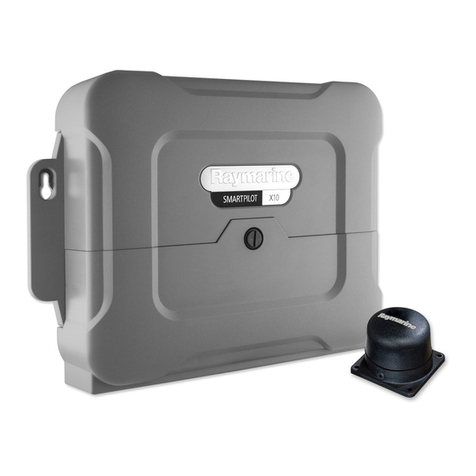
Raymarine
Raymarine SmartPilot X-10 installation guide
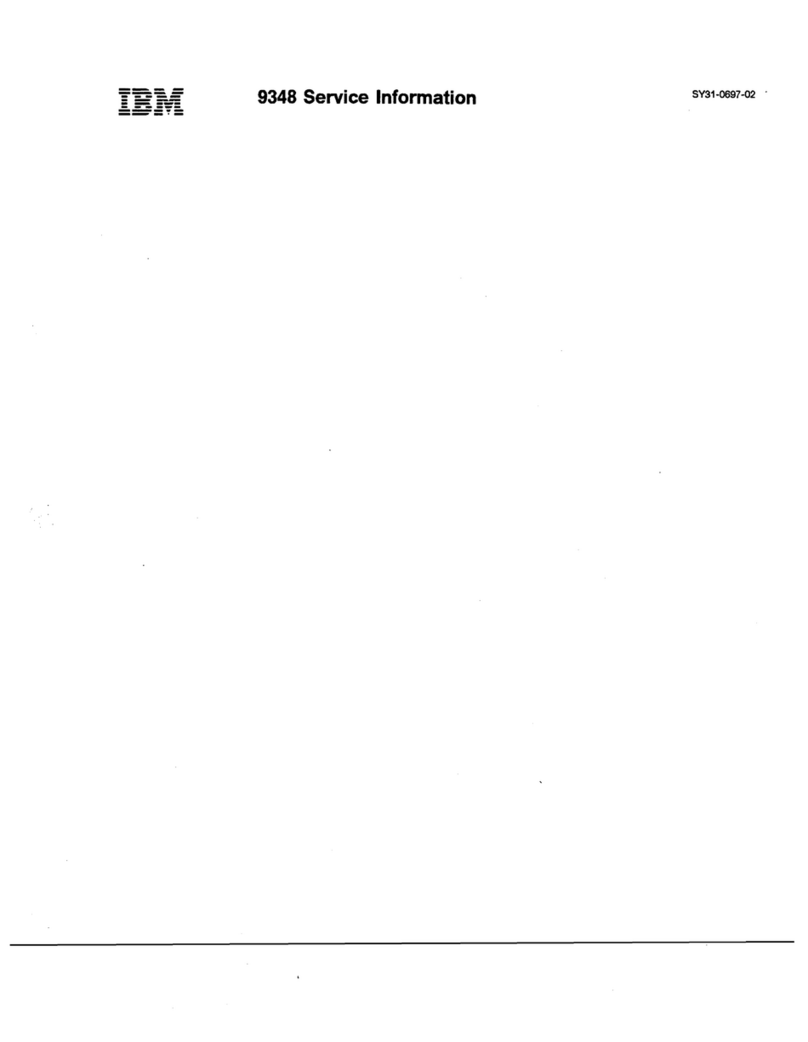
IBM
IBM 9348 Service information
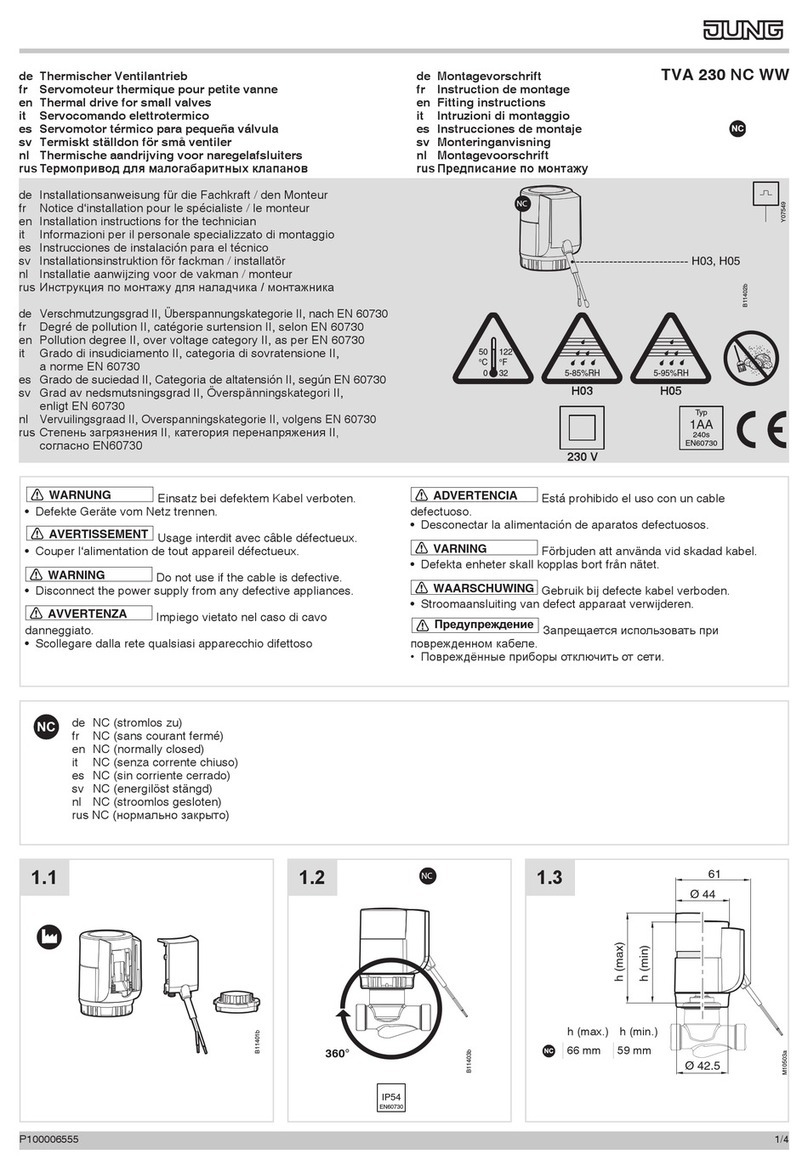
Jung
Jung TVA 230 NC WW Fitting instructions

D+H
D+H FRA 11-BSY Plus Original instructions
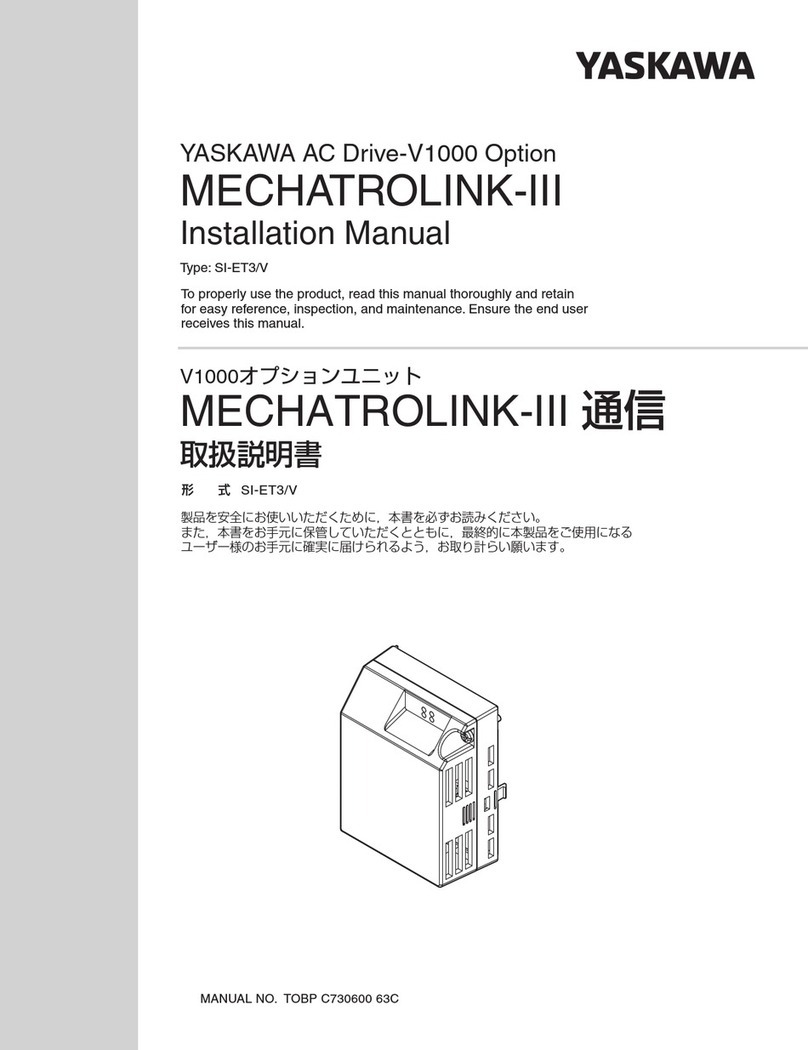
YASKAWA
YASKAWA MECHATROLINK-III installation manual
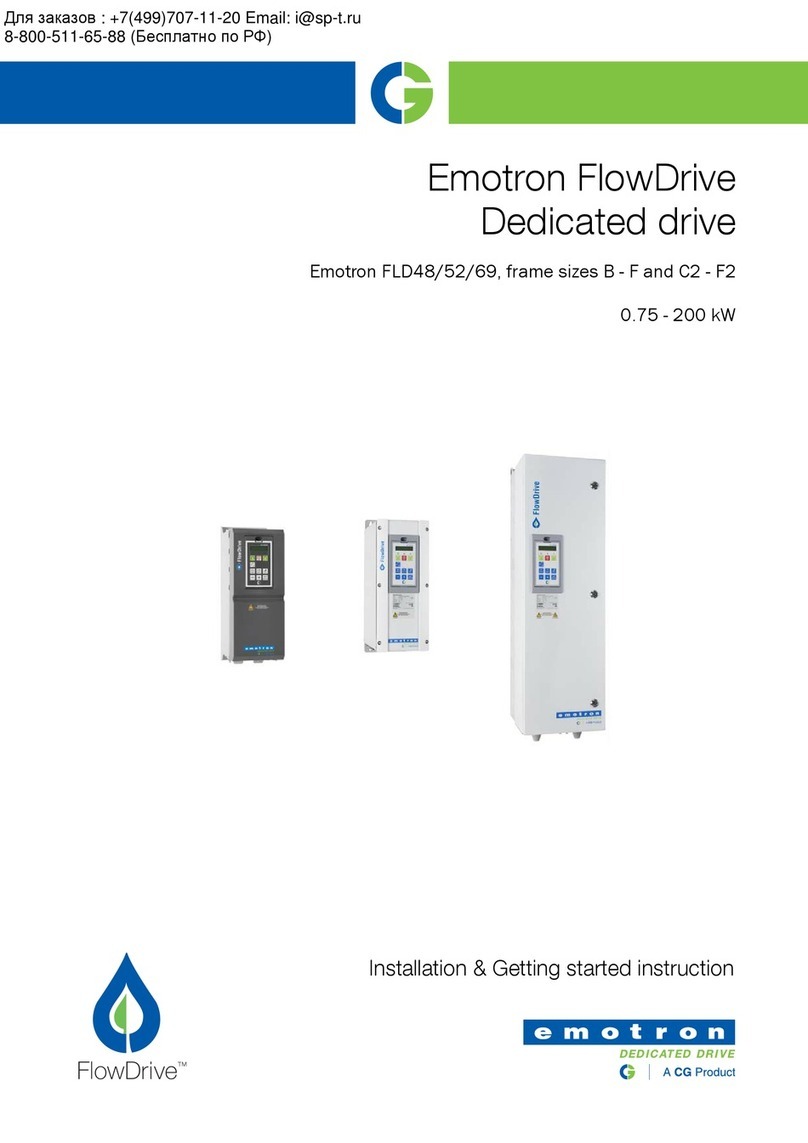
Emotron
Emotron FlowDrive Emotron FLD48 Installation & Getting started instruction

